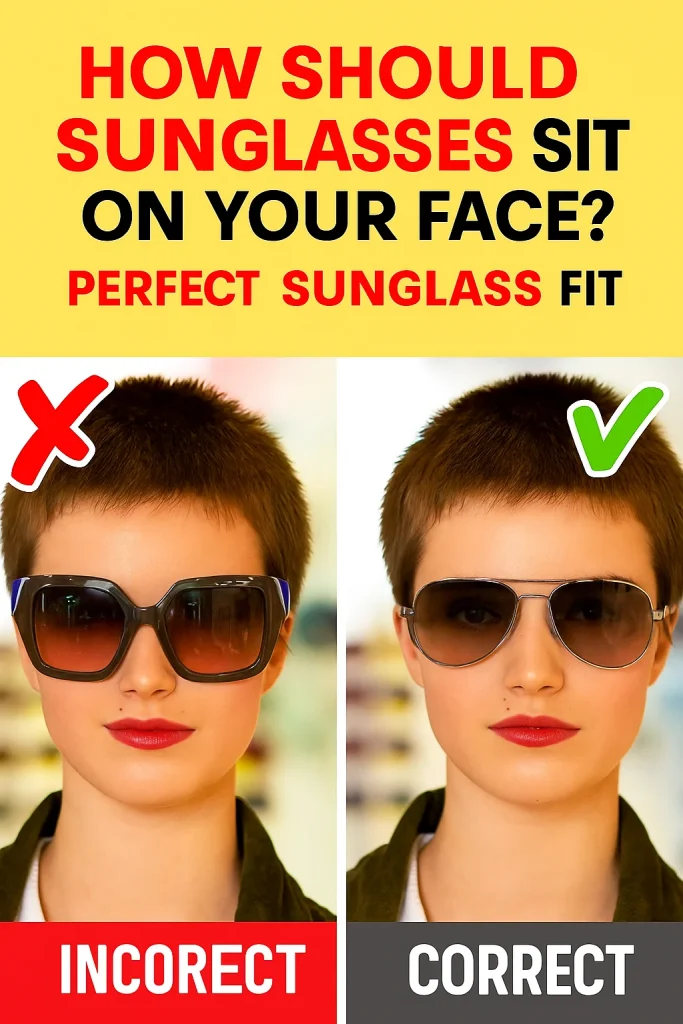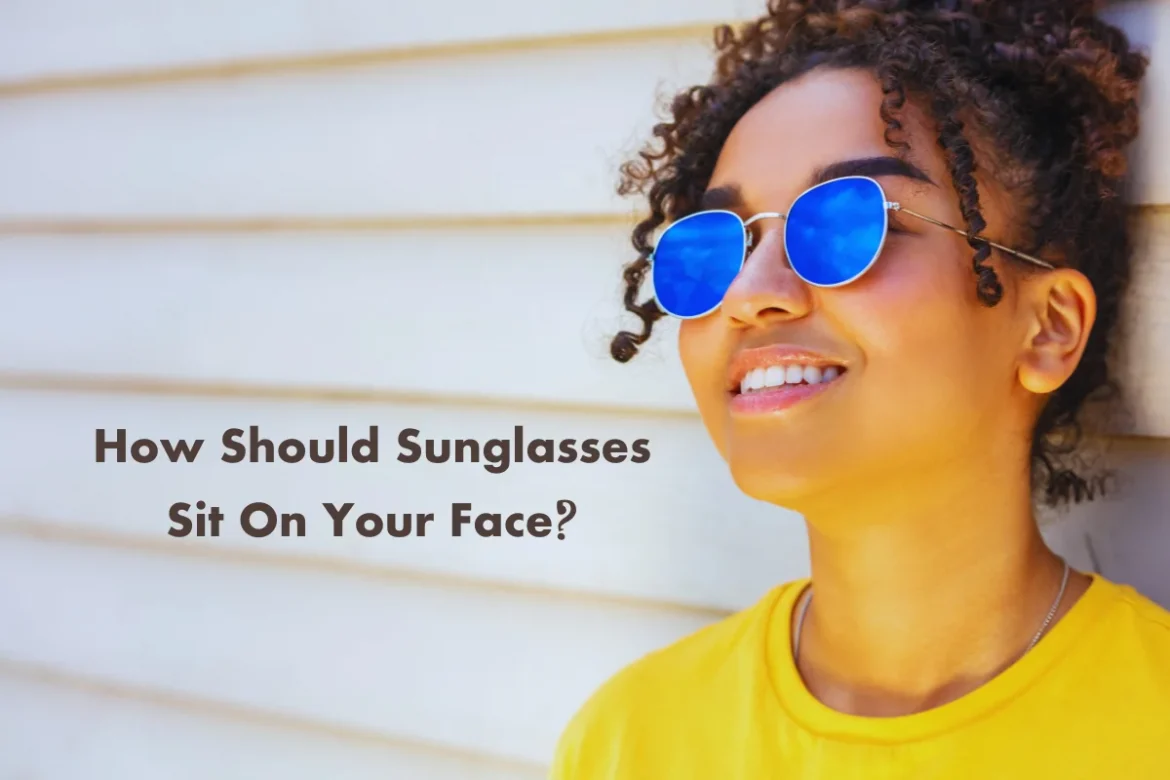Wearing sunglasses is not just about looking cool. How your sunglasses sit on your face is just as important. A good fit means maximum comfort, effective eye protection and a flattering look.
Sunglasses that don’t sit right can slide down your nose, pinch your temples or leave marks on your skin. This can be uncomfortable and even give you headaches.
Poorly fitting sunglasses may also not block out UV rays properly or reduce glare. This can put your eye health at risk. Whether you wear sunglasses for daily protection, outdoor activities or fashion, knowing how they should sit on your face can make a big difference.
In this blog we will cover the key areas where sunglasses should sit, from the nose bridge to the temples and frame width.
You will also get practical tips on how to test the fit and adjust your sunglasses for comfort and style. By the end you will know how to choose or adjust sunglasses that stay in place, look good and protect your eyes.
Why Proper Sunglass Fit Matters
A good sunglass fit is essential for your eyes. When sunglasses fit well they block out UV rays and reduce glare by sitting close to your eyes with no gaps. Poorly fitted sunglasses can let in sunlight from the sides or bottom which reduces their protective benefits.
Comfort is another reason why fit matters. Sunglasses that are too tight can cause pressure around your temples or behind your ears.

This can give you headaches or soreness. Loose sunglasses can slip down your nose and you have to constantly adjust them. This is annoying and distracting.
Finally the right fit enhances your overall look. Sunglasses that sit right highlight your facial features and boost your confidence. When your sunglasses fit comfortably and look good you will wear them more often and keep your eyes safe and stylish every day.
Key Areas Sunglasses Should Sit on Your Face
A good pair of sunglasses doesn’t just look good, it fits your face comfortably and securely. To achieve this you need to know how sunglasses should sit in four main areas: the nose bridge, temple arms, frame width and lens positioning. Getting these right means your sunglasses protect your eyes properly, feel comfortable and look good.
Nose Bridge Fit
The nose bridge is where your sunglasses sit on your nose. This area is key to comfort and stability. Sunglasses should sit firm but not tight on the bridge without pinching or leaving marks.
If they pinch you’ll get uncomfortable or headaches. If they slide down you’ll have to keep pushing them back up.
People have different nose shapes, so nose bridge designs vary. Some sunglasses have adjustable nose pads that can be gently bent to fit your nose better. These are common on metal frames and allow for a customized fit. Other frames have fixed plastic bridges that work best if they naturally match your nose shape.
For those with low or flat nose bridges, look for frames with wider, softer nose pads or wraparound styles that provide better grip. If you have a narrow or high bridge, thinner nose pads or narrower frames usually fit better.

If your sunglasses don’t fit well at the nose, visit an optical shop. Many stores offer free adjustments to bend nose pads or reshape frames to fit your face better.
Temple Arms and Ear Position
The temple arms, also called the “arms” or “legs,” extend from the frame over your ears. Their length and curve are crucial for keeping sunglasses in place without causing discomfort.
Properly fitting temple arms should curve gently around your ears and sit comfortably without digging into the skin. If the arms are too tight, they can cause pain or soreness behind your ears. This pressure might lead to headaches after prolonged wear. If the temple arms are too loose or too short, your sunglasses will slip or feel unstable.
One simple test is to put on your sunglasses and shake your head gently. The sunglasses should stay put without shifting or falling. If they move too much, you may need longer or better-curved temple arms.
Adjustable temple arms are common in some designs, and many optical stores can reshape the arms slightly for a better fit. If you wear headphones or ear accessories, consider how the temple arms interact with them to avoid discomfort.
Frame Width and Cheek Clearance
Frame width refers to how wide the sunglasses are across your face.
If the frame is too narrow, it will pinch the sides of your head and cause discomfort. If it is too wide, the sunglasses may slide down or feel loose.
Besides width, consider cheek clearance. Sunglasses should sit high enough so that the bottom of the frames does not touch your cheeks or cause marks. This is especially important for larger or wraparound frames. Frames that touch your cheeks can leave red marks and cause irritation, especially if you smile or talk frequently.
To avoid this, try different frame sizes and shapes to see which ones allow enough space between your cheeks and the lenses. Adjustable nose pads can help raise the frame slightly for better cheek clearance.
Lens Positioning
Where the lenses sit in relation to your eyes is also important. Sunglasses should cover your eyes fully to protect against sunlight and glare but should not block your vision or feel heavy on your face.
The lens height should allow you to see comfortably without obstruction. Frames that sit too high may press against your eyebrows or forehead, causing discomfort or interfering with natural movement. Frames that sit too low can let sunlight enter from above or sides, reducing protection.
The ideal position allows the lenses to cover your entire field of vision, including the peripheral areas, without feeling bulky or restrictive.
For outdoor activities or sports, a snug fit close to your face is preferable to prevent light from entering at awkward angles. For casual wear, comfort and style take priority, but protection should not be compromised.
How to Test the Fit of Your Sunglasses
Testing the fit of your sunglasses is easy and will save you from discomfort later. At home, put the sunglasses on and gently shake your head from side to side. Well-fitting sunglasses should stay in place without sliding down your nose or falling off.
Next, check for any pressure points around your nose or behind your ears that will cause discomfort after a while.
When trying sunglasses in-store, look for these signs of a good fit: the frame should sit evenly on your face without tilting, the temple arms should curve around your ears and there should be no gaps for sunlight to get in from the sides or top. Make sure the lenses cover your eyes fully for maximum protection.

If the fit isn’t perfect, many stores will do minor adjustments like bending the temple arms or nose pads for a better fit.
At home you can sometimes gently adjust plastic frames by warming them slightly (with warm water, not heat sources) to mold them to your face shape. But be careful and consult a professional for expensive or delicate frames.
Tips for Different Face Shapes
Your face shape plays a big role in how sunglasses should fit and look. Here’s a quick guide for different face types:
Round faces look good with angular frames like square or rectangular shapes that add structure and balance soft curves.
Can Round Face Shapes Wear Aviator Sunglasses? Indetail Guide
Oval faces are versatile and can wear most frame styles, but frames that are wider than the broadest part of the face usually look best.
Square faces look great with round or oval frames that soften strong jawlines and features.
Heart-shaped faces work well with frames that are wider at the bottom, like aviators or rimless styles that balance a broad forehead.
Diamond faces suit cat-eye or oval frames that highlight cheekbones and soften narrow forehead and chin areas.
Choosing frames that suit your face shape also means choosing ones that fit well, frames should align with the width of your face, sit on your nose and rest on your ears. If you’re unsure which style suits you best, check out our guide on how to choose the right sunglasses for your face shape. Remember, a frame that fits well will always look better and feel more comfortable, no matter your face shape.
When to Get Professional Adjustment or Custom Fit
If your sunglasses are uncomfortable despite your best efforts, it’s time to get professional help. Signs you may need expert adjustment include persistent pressure behind the ears or on the nose, frames that keep slipping or tilting and uneven alignment when worn.
Professionals can reshape temple arms, adjust nose pads or modify frame width to fit your unique face.
For those who need prescription sunglasses, custom fittings are essential to ensure clear vision and a comfortable fit. Opticians can provide lenses and frames to your exact measurements, improving both performance and comfort.
Investing in professional adjustments or custom fittings can make all the difference in enjoying your sunglasses throughout the day.
Conclusion
A proper sunglass fit is key to comfort, style, and most importantly, eye protection. Ill-fitting sunglasses can cause discomfort and reduce the effectiveness of UV and glare protection. Taking the time to find the right fit ensures your sunglasses stay secure, feel comfortable, and look great.
Remember, sunglasses are more than just a fashion accessory—they are a vital tool to protect your eyes. Prioritize comfort and protection when choosing your next pair, and don’t hesitate to get professional adjustments if needed. Well-fitted sunglasses will help you enjoy clear vision and safeguard your eyes for years to come.
FAQ: Sunglasses Fit Questions
How tight should sunglasses be on your face?
Sunglasses should feel snug enough to stay in place without causing pressure or pain. Too tight can cause headaches or soreness, while too loose means they will slip and need constant adjustment.
Should sunglasses rest on your nose or ears more?
Both areas share the weight. The nose bridge supports most of the frame’s weight, while the temple arms rest comfortably behind the ears to keep sunglasses stable without pinching.
Can poorly fitting sunglasses damage your skin?
Yes. Tight frames can leave marks, cause irritation, or even bruising over time. Constant friction or pressure may lead to redness or discomfort, so proper fit is essential.
How do I know if my sunglasses are too loose?
If your sunglasses slide down your nose easily, shift when you move your head, or fall off frequently, they are too loose and need adjustment or a better-fitting frame.
Can sunglasses affect my vision if not fitted properly?
Yes. Poor fit can cause lenses to sit too far or too close, leading to distorted vision or letting sunlight enter from the sides, reducing protection and causing eye strain.


